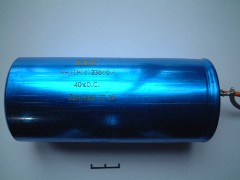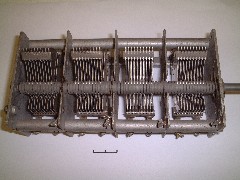


A selection of low voltage ceramic capacitors.

Polyester capacitors.
Note the large values possible.

A selection of polystyrene capacitors.
These capacitors have accurate values and low temperature coefficients.

A dismantled polystyrene capacitor.
Note - the two pieces of aluminium foil and the two pieces of polystyrene sheet.

A selection of tantalum bead capacitors.
These capacitors have accurate values and low leakage currents.
Note - they are still polarised

A 33000µF, 40V electrolytic capacitor.

A 0.47F capacitor.
It was used to maintain the settings for the stations in a video recorder.

A selection of low voltage electrolytic capacitors.
Note - the polarity markings on each one.

A twin gang air spaced tuning capacitor.
The maximum value for each section is 68pF.
The wide plate spacing make it suitable for a high voltage, high power transmitter.

A four gang tuning capacitor.
The maximum value of each section is 500pF.
This was originally from a radio which had two tuned rf amplifiers,
a tuned mixer and a local oscillator.

A small variable capacitor.
Note - the overlapping plates.

A tuning capacitor where the dielectric separating the plates is thin plastic.
The maximum capacitance of this is 500pF.

A miniature twin gang tuning capacitor.
This tuning capacitor has two low value sections on the left for VHF radios.
The two high value sections are on the right.
The maximum value of each of these is 300pF.